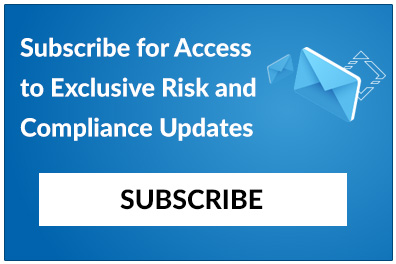Home/ Blog / Foundations of Regulatory Compliance for Financial Organizations
Amid the complexity of evolving GRC measures and expectations from compliance regulators, the foundational principles of regulatory compliance remain constant for those in the insurance, fintech, and banking industries.
Revisiting the principles that guide compliance professionals, from best practices to the concerns of various regulatory bodies, is essential to understanding the acceleration of risk across different enterprise layers as well as the need for integrated regulatory compliance management.
Building a Responsive Risk Culture
While keeping up to date with the latest developments in regulatory change is crucial, certain foundations remain integral to any powerful system for regulatory compliance best practices, such as establishing:
- Clear chains of responsibility, from senior management to front-line personnel, establishing compliance as a culture.
- Regular risk assessments and documentation.
- Policies and processes that ensure internal actions consistently align with regulatory requirements.
- Continuous education and open channels that keep teams aware of evolving regulations.
- Real-time data and systematic audits to ensure deviations are quickly identified, reported, and addressed.
These best practices do not exist in isolation, however, and are influenced by changes suggested by US regulatory bodies. Remembering the purpose and importance of these different entities enables organizations to future-proof their risk management systems.

The Regulatory Ecosystem
Over the decades, regulatory expectations have evolved in what can be classified as three distinct waves.
In the first wave, regulators were simply demanding compliance, which organizations could adhere to by maintaining checklists and audit trails.
The second wave saw regulators expecting to see effective control systems and ongoing monitoring implemented by organizations.
Lastly, the third wave, where most organizations now operate, demands the integration of a risk culture. This means fostering an environment where employees at all levels understand regulatory obligations and contribute to managing risk.
Implementing these living, breathing frameworks means continuous monitoring of guidance from various US regulatory bodies, including, but not limited to:
| Regulatory Agency | Purpose |
|---|---|
| OCC (Office of the Comptroller of the Currency) | Oversees national banks and federal savings associations, emphasizing sound banking practices, consumer protection, and operational resilience. |
| FDIC (Federal Deposit Insurance Corporation) | Provides deposit insurance and ensures financial soundness among state-chartered banks not part of the Federal Reserve, with a strong focus on risk and consumer safeguards. |
| Federal Reserve | Regulates bank holding companies and state-chartered banks with systemic risk initiatives. |
| CFPB (Consumer Financial Protection Bureau) | Concentrates on fair and transparent consumer financial products. |
| SEC (Securities and Exchange Commission) | Enforces federal securities laws, requiring public companies to disclose financial information and significant developments. |
| State-Level Regulators | Supervise state-chartered banks, credit unions, and insurance companies, enforcing both state-specific and federal requirements tailored to local economic conditions. |
| International Authorities (Basel Committee, FATF, etc.) | Set globally recognized guidelines for capital adequacy, risk management, and AML/CTF standards that member nations adopt into domestic law, fostering cross-border regulatory alignment. |
The interdependencies between these agencies create a cascading effect. For example, a change in FDIC guidance may trigger updates to OCC interpretations, or new CFPB enforcement trends may shape SEC expectations.
For compliance professionals, this requires staying current not just with individual agency changes to regulations but also understanding how regulatory shifts affect the entire regulatory ecosystem.
However, it may not always be clear what the best approach is to interdependent regulatory changes from these different bodies. Apart from the foundational practices of coordination and organizational transparency, a holistic perspective is needed to create an integrative strategy for regulatory compliance.
Understanding Regulatory Interdependencies
Reemphasizing the link between regulatory bodies is useful for creating a risk management strategy that factors in unexpected compliance obligations.
For example, when the CFPB issues guidance on fair lending practices, this guidance does not solely affect consumer lending teams but also influences how the OCC evaluates lending risk management, which in turn affects how the Federal Reserve assesses systemic risk in bank holding companies.
These regulatory interdependencies can appear in several critical ways, such as:
- Overlapping Jurisdictions
Fair lending practices, for example, sit at the intersection of OCC, FDIC, Federal Reserve, CFPB, and Department of Justice oversight. - Enforcement Priorities
An example of this is when the OCC emphasizes third-party risk management in its examination guidance; the FDIC and Federal Reserve typically release complementary guidance within months. - Influence of International Standards
The Basel Committee on Banking Supervision, the Financial Action Task Force (FATF), and other international bodies increasingly shape U.S. regulatory expectations. - State and Federal Coordination
For example, a state regulator might adopt federal guidance wholesale, or it might demand additional requirements.
A compliance team that monitors each agency in isolation will miss the full scope of these requirements. For example, addressing FDIC guidance without realizing it requires updates to SEC disclosures, may result in non-compliance and increase potential risk exposure.
Integrated Risk Management for Organizations
Risk can no longer be sufficiently mitigated through manual data gathering that is spread across departmental silos but rather calls for a data-integrated approach.
Information from multiple teams that are not consolidated in a single system leads to reactive, rather than proactive, audit responses.
Some of the main limitations of manual risk management include:
- Increased possibility of human error
- Resource-intensive audits
- Delayed action on compliance issues
- Duplicate compliance efforts across teams, wasting resources
- Regulatory changes inefficiently tracked in email chains and spreadsheets
- Increased likelihood of missed deadlines
- Audit findings that recur because root causes have not been addressed
- Lost institutional knowledge when compliance staff transition
US regulatory bodies increasingly expect financial organizations to show an integrated view of compliance and risk. They want to see that an institution understands how a lending risk in one division connects to liquidity risk in another, and how both relate to regulatory capital requirements.
The Case for GRC Technology
The use of GRC tools like Predict360 helps organizations employ the necessary measures and mitigate increased risk exposure. GRC management platforms enable data-driven compliance conversations.
In this way, compliance becomes a strategic function that quantifies risk, prioritizes mitigation efforts, and helps business leaders make informed decisions.
Predict360 directly addresses regulatory these compliance issues with:
- Regulatory Change Intelligence
Monitors regulatory changes and flags their impact on your institution’s compliance. - Risk-to-Regulatory Mapping
Displays operational risks, controls, and compliance requirements in a single system, showing where vulnerabilities exist. - Workflow Automation
Routes compliance tasks, reminders, and approvals automatically, reducing delays and human error. - Audit Evidence Management
Centralizes documentation so that when examiners arrive, your compliance story is coherent. - Departmental Transparency
Enables compliance, audit, risk, and business teams to work from a sole source of truth.
The capabilities offered by intelligent GRC platforms help guide organizations away from unnecessary risk, towards demonstrable compliance.
This integrated risk management approach:
- Reduces manual errors
- Breaks down silos between compliance, audit, risk, and business
- Enables compliance teams to shift focus from manual data collection and interpretation towards strategic initiatives
The foundations of regulatory compliance have not changed. What has evolved is the complexity of how to demonstrate these foundations across an expanding regulatory ecosystem and an increasingly complex risk landscape.
The interdependencies of modern regulatory change mean that proper compliance has become a strategic capability. Organizations need to create a compliance culture, rather than a checklist, through intelligent platforms and a deeper understanding of GRC foundations. This approach will avoid regulatory penalties and gain competitive advantages through operational resilience and increased stakeholder trust.
Request a Demo
Complete the form below and our business team will be in touch to schedule a product demo.
By clicking ‘SUBMIT’ you agree to our Privacy Policy.


